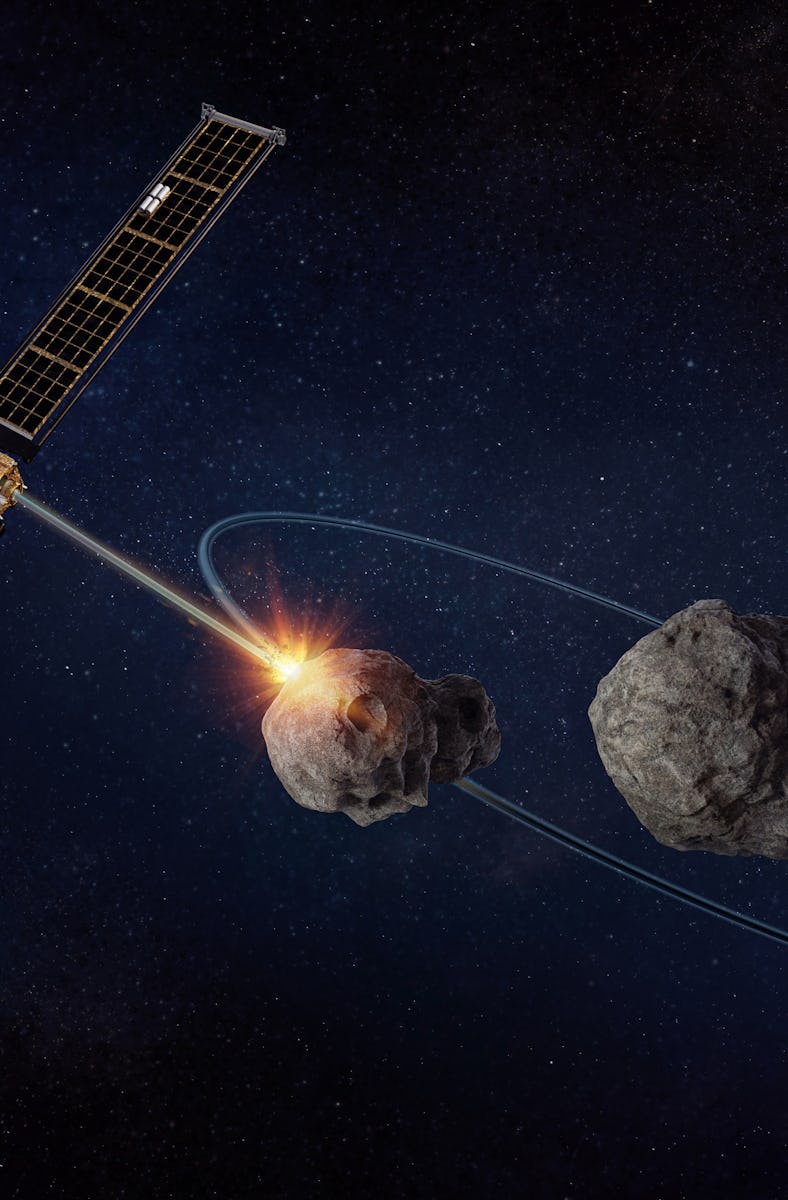NASA Didn’t Just Redirect An Asteroid — It Reshaped It
Forget a little misdirection; DART rearranged almost a tenth of asteroid Dimorphos's mass.

NASA’s DART mission didn’t just put a dent in tiny asteroid moonlet Dimorphos: the impact may have actually changed Dimorphos’s shape entirely.
Dimorphos, an asteroid about 500 feet wide, orbits a ten-times-larger asteroid called Didymos. Last February, NASA crashed a 580-kilogram spacecraft called DART into Dimorphos, knocking the moonlet onto a different orbital path around Didymos. A recent study published in the journal Nature Astronomy. suggests that Didymos is so small, and so loosely held together, that the DART impact actually deformed the whole moonlet instead of leaving a crater. That could have interesting implications for future efforts to protect ourselves from much larger asteroids that wander too close to Earth.
Making a Big Impact on a Little Asteroid
Before the impact, Dimorphos was a little longer in one direction than the other two – a bit like a stumpy potato. But according to University of Bern Physicist Sabina Raducan and her colleagues’ simulations, DART blasted about 8 percent of the asteroid’s mass away from one end of the asteroid, then piled it up along the middle. Dimorphos is now a little closer to round than it was before we crashed a spacecraft into it.
Raducan and her colleagues made this discovery using data from the DART impact to build digital models of the asteroid’s structure and makeup. The model version of Dimorphos looks to be a loosely grouped pile of rocky rubble.
That fits well with astronomers’ predictions that Dimorphos is a rubble-pile asteroid, cobbled together from stray chunks of its parent asteroid Didymos. According to Raducan and her colleagues, the chunks of rock that make up Dimorphos (most of which are less than 8 feet wide) are loosely held together by each other’s gravity, and there’s not much fine-grained dust in between to help stick them together. Dimorphos’s rubble-pile composition played a role in how the moonlet responded to DART’s impact.
Namely, when DART slammed into the rubble surface of Dimorphos, the impact blasted debris upward and outward. From Earth, astronomers saw a huge plume of debris trailing 6,000 miles behind the asteroid, gleaming with reflected sunlight. According to Raducan and her colleagues’ simulations, DART also knocked 8 times more rocky material into orbit around the moonlet – and it eventually settled far from the site of the impact.
“This material was either ejected at velocities below the escape threshold or was gently lifted from the expanding crater cavity,” Raducan tells Inverse. “Essentially, the resulting feature is not an impact crater but rather a deformation of shape, as the resulting crater was larger than the body itself.”
This animation shows how DART’s impact reshaped Dimorphos.
Reshaping Versus Redirecting Asteroids
On one hand, the fact that we’ve now changed the shape of an object in our Solar System is probably some sort of spacefaring civilization milestone in its own right — achievement unlocked! But DART’s whole purpose was to test whether we could defend Earth by using spacecraft like DART to knock potentially dangerous asteroids off-course. We now know that the mission was a success in this aspect as well; DART changed Dimorphos’s orbit around Didymos by about 33 minutes (out of an original 11 hours and 55 minutes). In other words, we knocked it onto a different trajectory, and on a larger scale, that could be enough to turn a potential global catastrophe into a near-miss.
But pulling that off reliably will require understanding the detailed mechanics of exactly how and why it happened, and scientists are still crunching the numbers on that.
“If an asteroid were to pose a threat to Earth, we could employ our models to forecast its reaction to a kinetic impactor,” says Raducan.
Most of the 33 minute change in Dimorphos’s orbit came from the sheer momentum of DART smacking into Dimorphos. But previous work by Georgia Tech researcher Ryota Nakano, a coauthor of the recent study, suggests that about 100 seconds of the change were thanks to how the impact deformed Dimorphos’s shape. A change in how the rubble-pile moonlet’s mass was distributed would also change its gravitational field – and thus the way it orbits Didymos.
“Knowing how deformation and ejecta recoil could also change the orbital period helps us to deepen our understanding of the kinetic deflection technique effectiveness and better prepare the technique for future planetary defense initiatives,” explains Nakano.
What’s Next For Dimorphos and Didymos
The European Space Agency’s Hera mission, set to launch this October, will fly past Dimorphos and Didymos in 2027, on its way to Jupiter. Once that happens, we’ll know a lot more detail about how DART impacted the moonlet and its orbit.
“Once Hera’s data becomes available, we can compare the data to the images of Dimorphos taken by the DART spacecraft and know exactly how much deformation has occured due to the DART impact,” says Nakano.
If there’s a crater in the moonlet’s surface, we can’t see it from here – that will be up to Hera in 2027, when it passes Dimorphos on its way to Jupiter. But according to Raducan and her colleagues, Hera probably won’t find a crater. Instead, it will find a moonlet completely reshaped by DART’s impact.